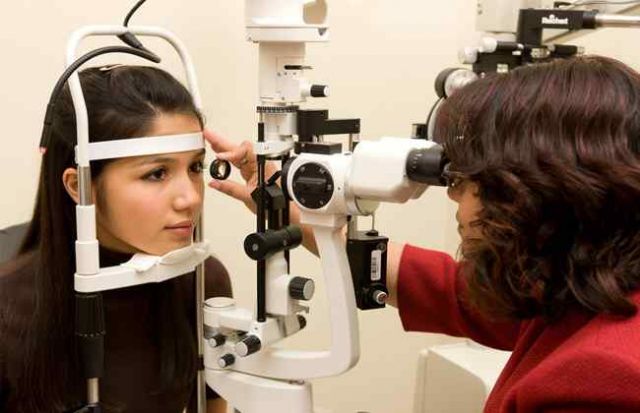Most eye problems that occur in infants can be considered not a serious condition, although should not be ignored as well. What to watch out for is if it is not handled properly, it is not possible the problem can become more serious.
As an anticipatory action, Father and Mother need to recognize the signs of danger that can threaten the power of vision of the baby as well as handling that can be done at home.
Here are three common eye problems experienced by infants and recommended handling measures.
Treat Eye Turn (Strabismus)
In the first few months of her life, some babies have cross-eyed aliases. This is because the muscles that control the baby's eyes are still weak. However, the eyeball is usually straight aligned since the baby stepped on the age of 4-6 months. Immediately consult a pediatric ophthalmologist, if the cross-eyed eye is detected as strabismus with signs:
- The baby is more than 4 months old, but the eyeballs still deviate up, down, in, or out. This condition can involve only one eye or both eyes.
- Eye irregularities occur at the same time each day or during certain activities.
When detected early, strabismus can be resolved through a variety of effective and safe treatment options. Ignoring it or waiting too long to handle it can actually trigger permanent loss of vision. The important key here is the condition of strabismus in the child should be addressed immediately.
Clogged Tears Channel
In general, the eyes become watery because of crying or the presence of blockage in the tear ducts. While in infants, the cause of watery eyes is usually the delay of development and opening of the baby's tear ducts. Do not worry because this is usually not a serious condition. About 1 in 20 babies can experience this condition, either on both eyes and one eye. Generally, infants themselves are not disturbed by such conditions.
However, this condition can certainly lead to infection if not treated. In clogged tear duct conditions that do not become infected, the eye fluids are small and are white or yellowish. This fluid will be dirt during baby sleep. While in conditions ending in infection, many eye fluids and are yellow or green are continuing throughout the day.
Here are some steps you can take to deal with the blockage of the baby's tear ducts.
- Compress the corner of the eye near the nose with warm water and a gentle massage.
- Use your finger to gently press the outer side of the baby's nose, sweep down to the corner of the nose. Repeat as many as ten times per day. Most babies can get better with this massage so it does not require continued treatment. Make sure Mother's hands are clean.
- If there is dirt or tear, wash with a clean cloth or cotton that has been softened with clean water. Make sure the water has been cooked until boiling then cooled.
- Call your doctor when the discharge of pus and eye contact occurs throughout the day.
- Minor surgery may be needed if the tear ducts are still blocked, even though your baby is six months old. In some cases, Mother may need to wait until the baby is one year old. All depends on the doctor's examination. The operation itself aims to clean the tear ducts. When the channel is open, either by itself or by operation, the channel will usually still open and will not cause any more problems.
Infection
When the baby's eyes are contaminated by bacteria, the white part of the eye can become very red in color and may secrete pus and dirt. Conditions that can make eyes feel sore and itching is called conjunctivitis. In addition to bacterial contamination, other causes are due to irritation, allergic reactions, or anything else that may be more serious. Immediately consult a doctor if your baby has these conditions.
Doctors usually prescribe ointments or antibiotic eye drops that need to be taken for several days. Wash hands and make sure the cleanliness before and after Mother apply ointment, give eye drops, or touch the area around the baby's eyes. Also, avoid contact with baby's eyes.
To ensure the health of the baby's eyes, parents should not forget to perform antenatal checks, ie checks from head to toe, including specific examinations of the eyes, heart, and hips. Especially for baby boys will be added with testicular examination. An antenatal examination should first be performed within the 72 hours after delivery and performed again at weeks 6-8.
Danger Signs of Vision Problem
Parents also need to recognize the danger signs of vision problems in infants. Immediately check with your doctor if the baby has one or more of the following danger signs.
- One baby's eyes never open.
- The baby's eyes are not moving normally, for example one of the eyeballs is moving and the other is not or one of the eyeballs is looking in a different direction when the other one is moving.
- Babies always have unusual white spot marks on their eyes when photographed using a camera with flash.
- The baby's eyes look cloudy, like there are white, grayish, or yellow in pupils.
- The baby often rubs his eyes when he is not sleepy.
- Babies look sensitive to light.
- Babies often squint.
- One of the baby's eyes is bigger than the other.
- The baby's eyelid looks limp.
- One or both eyes of the baby look prominent.
- Babies do not pay attention to movement, light, or other disorders when he was more than a month old.
- Parents find a change in their eyes compared to the usual situation.
Note also the following signs when your baby is three months old.
- Baby's eyes do not follow the movement of the toy that is in front of him.
- Babies seem to tilt their heads when they see things.
- Baby's eyeballs move inward or outward and stay that way.
- Baby's eyeballs look like jumping or shaking back and forth.
Parents also need to play an active role to help develop the vision of the baby. The trick, among others, by changing the position of the baby's crib and baby's position regularly and use a light sleeper or dim light in the nursery. Talk to Little One, change left and right position while nursing, and place the toy inside the baby's focusing focus, which is about 20-30 cm away from it. All these actions can provide stimuli that help the visual development of the baby.
 webDailyHealth
webDailyHealth










